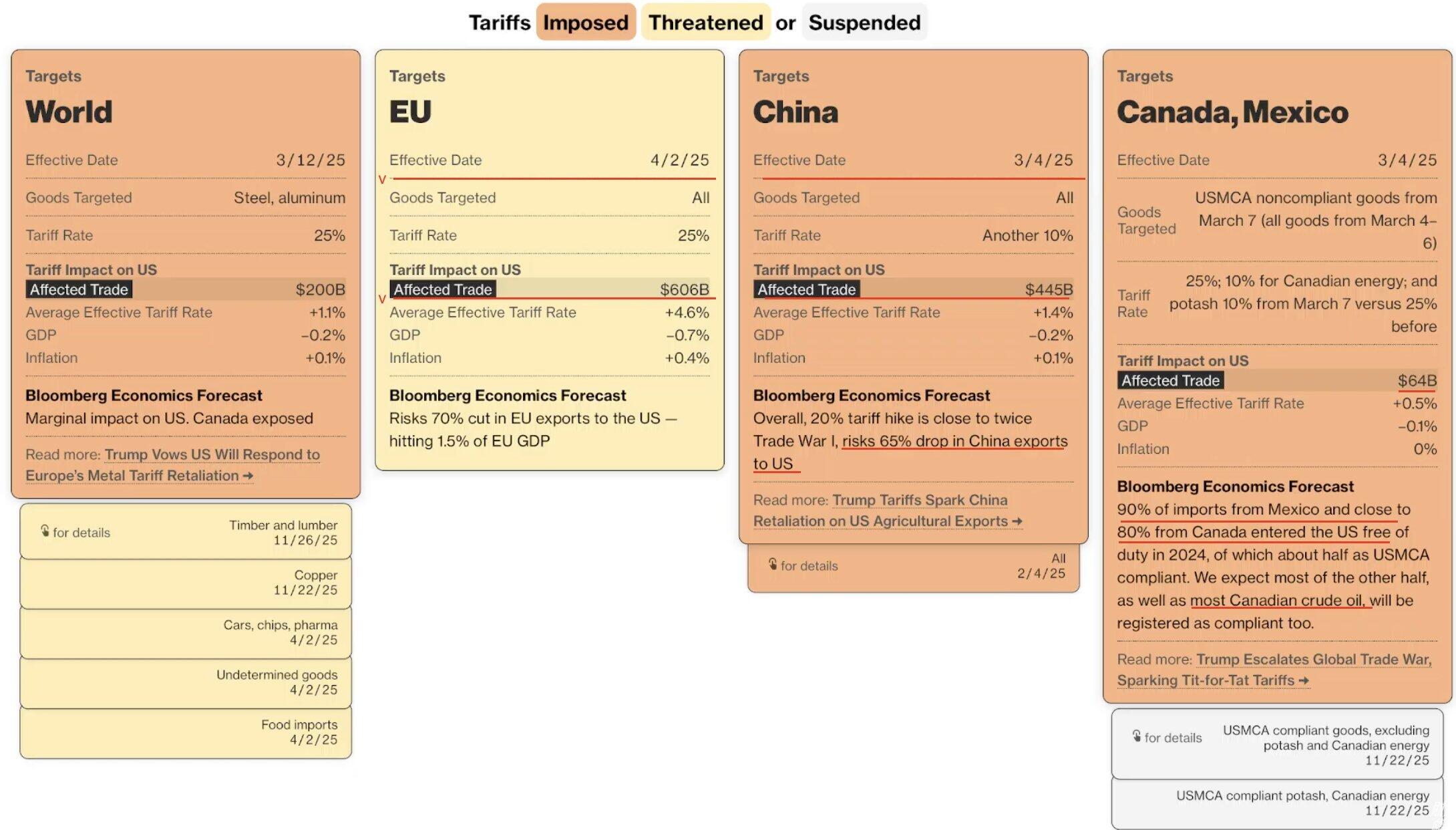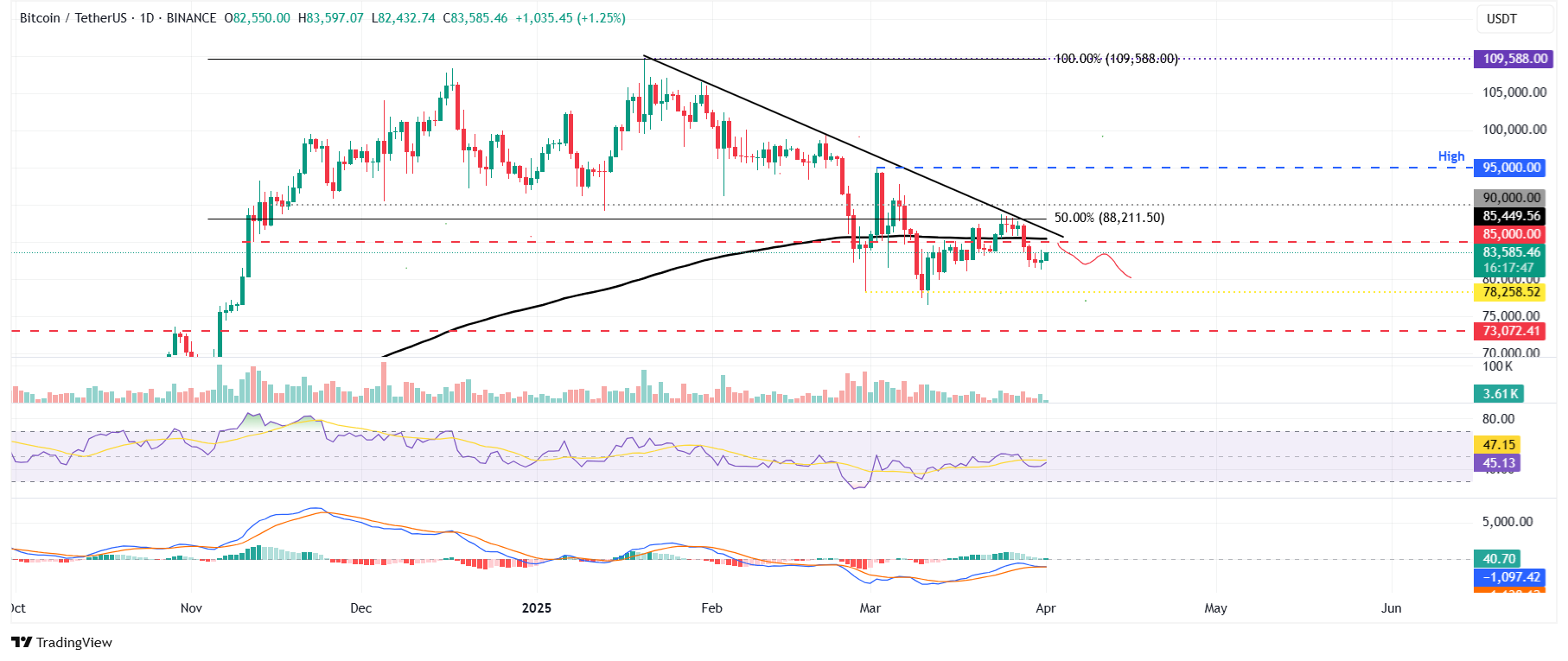- Bitcoin’s price has seen a slight rebound, trading above $84,000 on Tuesday, following a 4.29% drop the previous week.
- Reports indicate that Bitcoin’s market dominance has climbed to 61.4%, showcasing a shift towards BTC as a stable asset during times of market turbulence.
- Economic uncertainties, tariffs imposed by former President Trump, and risks of stagflation could exert downward pressure on Bitcoin due to its correlation with equity markets during risk-averse periods.
As of Tuesday, Bitcoin’s (BTC) price has recovered slightly, trading above $84,000 after stabilizing on Monday, following a decline of 4.29% the week before. Reports note an increase in Bitcoin’s dominance to 61.4%, demonstrating a trend towards BTC as a more resilient asset amid market challenges, which supports its recovery. Nevertheless, traders should exercise caution as ongoing economic uncertainties, the United States’ tariffs, and risks of stagflation might pressure Bitcoin due to its association with equity markets, especially in a risk-off environment.
Bitcoin recovers as dominance reaches 61.4%, with Tether acquiring $735 million in BTC
After a drop of 4.29% last week, Bitcoin’s price found stability around $82,500 on Monday. However, it has seen a slight recovery during the early European trading session on Tuesday, and is now trading above $84,000, reflecting a daily gain of 2%.
On Tuesday, reports highlighted that the widening gap between Bitcoin and the rest of the market indicates ongoing defensive strategies within the crypto sector.
“Bitcoin’s dominance has increased to 61.4%, highlighting a shift towards BTC as a comparatively more robust asset during market instability,” the report states.
The report also suggests that BTC is likely to maintain its relative strength as long as macroeconomic uncertainties and high volatility continue. However, should investor appetite return, a potential mean reversion in the performance of ETH/BTC and other altcoins might occur. For now, market conditions favor caution, and Bitcoin’s dominance is expected to stay elevated in the near term.
Additionally, Bitcoin’s recovery has been bolstered by news that Tether, known for issuing the USDT stablecoin, withdrew 8,888 BTC valued at $735 million from Bitfinex’s hot wallet on Tuesday, effectively adding to its Bitcoin reserves. Currently, Tether’s wallet holds 92,647 BTC, worth approximately $7.65 billion, making it the sixth-largest Bitcoin wallet.
This event is generally viewed positively for Bitcoin. Withdrawals from an exchange’s hot wallet to a non-exchange address, such as Tether’s reserve wallet, indicate that Bitcoin is less accessible for sale on the exchange, thus reducing short-term selling pressure. Tether’s acquisition also reflects strong institutional demand for Bitcoin.
Bitcoin may face downward pressures from economic uncertainties, Trump tariffs, and stagflation risks
A recent report pointed out that the US Trade Policy Uncertainty Index stands at 25%, “above the Trump Trade War 1.0 high” – a situation that has never happened historically.
As noted earlier, high levels of uncertainty and volatile market environments often lead to a risk-off attitude among investors as they seek out safer assets like Gold, which can reduce demand for cryptocurrencies.
US Economic Policy Uncertainty Index Chart
Furthermore, an analysis indicates that the tariffs being threatened against the European Union (EU) could potentially affect $600 billion in imports, leading to an estimated 70 basis points decrease in US GDP and an additional 40 basis points in inflationary pressure.
“We believe stagflation has already commenced,” the report states, aligning with warnings from Goldman Sachs predicting a 35% chance of recession in the upcoming year.

The current economic climate, characterized by Trump’s tariffs, stagflation apprehensions, and high uncertainty levels, suggests a difficult near-term outlook for Bitcoin, with potential downward pressure related to its correlation with equities amid risk-averse sentiment.
However, in the medium to long term, Bitcoin may serve as a hedge against inflation, stagflation, and a weakening US Dollar, particularly if the Federal Reserve shifts to a more accommodative policy stance.
Traders should stay vigilant and prepare for continued volatility in the weeks ahead, especially with the impending tariff implementation date on Wednesday, dubbed “Liberation Day” by Trump. Conversely, long-term investors may find opportunities to accumulate Bitcoin during price dips if concerns over stagflation persist.
Bitcoin Price Outlook: BTC bounces back above $84,000
Last week, Bitcoin’s price was fluctuating between $85,000 and $88,000. Nonetheless, it closed below this range on Friday and experienced a 5.53% decline by Sunday. BTC began the week around $82,500 and has since improved, trading above $84,000 at the time of writing on Tuesday.
The Relative Strength Index (RSI) on the daily chart is positioned at 45, trending upward towards the neutral level of 50, indicating a weakening bearish momentum. For the recovery rally to gain traction, the RSI needs to exceed its neutral point of 50.
The Moving Average Convergence Divergence (MACD) indicators are currently entwined, suggesting traders are showing indecision.
If BTC continues its recovery, it could test the daily resistance at $85,000. A successful breakout above this threshold could propel the rally towards the critical psychological milestone of $90,000.

BTC/USDT daily chart
Conversely, should BTC be unable to break through the daily resistance at $85,000, it may see a further decline towards the next support level at $78,258.
Bitcoin, altcoins, stablecoins FAQs
Bitcoin is the largest cryptocurrency by market cap, created to function as a currency. This digital currency operates without the control of a single individual, group, or entity, thus removing the need for third-party involvement in financial transactions.
Altcoins refer to any cryptocurrencies besides Bitcoin. However, some consider Ethereum as a non-altcoin due to its connection to Bitcoin in the forking process. If true, Litecoin would be the first altcoin, derived from the Bitcoin protocol, thereby positioning it as an “enhanced” version of Bitcoin.
Stablecoins are cryptocurrencies aimed at maintaining stable values, backed by reserves corresponding to the assets they represent. To achieve stability, the value of any given stablecoin is pegged to a commodity or financial instrument, such as the US Dollar (USD), with supply managed through algorithms or market demand. The primary objective of stablecoins is to provide a reliable on/off-ramp for investors interested in trading and investing in cryptocurrencies while also allowing them to store value since cryptocurrencies tend to be volatile.
Bitcoin dominance represents the ratio of Bitcoin’s market valuation to the overall market valuation of all cryptocurrencies. This ratio offers insight into Bitcoin’s appeal among investors. A high dominance of BTC generally occurs before and during bull markets as investors lean towards the relatively stable and higher market cap cryptocurrency like Bitcoin. Conversely, a decline in BTC dominance often signifies that investors are reallocating their capital and/or profits into altcoins, in pursuit of higher returns, which can trigger notable altcoin rallies.
